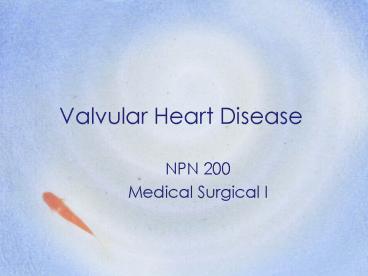Valvular Heart Disease - PowerPoint PPT Presentation
1 / 25
Title:
Valvular Heart Disease
Description:
Pulmonary congestion and right sided heart failure occurs ... Primarily caused by rheumatic heart disease, but may be caused by papillary ... – PowerPoint PPT presentation
Number of Views:930
Avg rating:3.0/5.0
Title: Valvular Heart Disease
1
Valvular Heart Disease
- NPN 200
- Medical Surgical I
2
Types
- Mitral Stenosis
- Mitral Regurgitation
- Mitral Valve Prolapse
- Aortic Stenosis
- Aortic regurgitation
- Tricuspid valve is affected infrequently
- Tricuspid stenosis causes Rt HF
- Tricuspid regurgitation causes venous overload
3
Tricuspid Valve
4
Rheumatic Heart Disease
- Inflammatory process that may affect the
myocardium, pericardium and or endocardium - Usually results in distortion and scarring of the
valves
5
Rheumatic Heart Disease, cont.
- Subjective symptoms
- Prior history of rheumatic fever
- General malaise
- Pain may or may not be present
- Objective symptoms
- Temperature
- Murmurs
- Dyspnea
- polyarthritis
6
Rheumatic Heart Disease
- Diagnosis
- H/P
- WBC and ESR
- C-reactive protein
- Cardiac enzymes
- EKG
- Chest x-ray
- Echo
- Cardiac cath
- Cardiac output
7
Rheumatic Heart Disease
- Nursing Care
- Vital signs
- Rest and quiet environment
- Give antibiotics, digitalis, and diuretics
- Provide adequate nutrition
- Monitor I/O
- Explain treatment and home care
8
Mitral Stenosis
- Usually results from rheumatic carditis
- Is a thickening by fibrosis or calcification
- Can be caused by tumors, calcium and thrombus
- Valve leaflets fuse and become stiff and the
cordae tendineae contract - These narrows the opening and prevents normal
blood flow from the LA to the LV - LA pressure increases, left atrium dilates, PAP
increases, and the RV hypertrophies - Pulmonary congestion and right sided heart
failure occurs - Followed by decreased preload and CO decreases
9
Mitral Stenosis, cont.
- Mild asymptomatic
- With progression dyspnea, orthopneas, dry
cough, hemoptysis, and pulmonary edema may appear
as hypertension and congestion progresses - Right sided heart failure symptoms occur later
- S/S
- Pulse may be normal to A-Fib
- Apical diastolic murmur is heard
10
Mitral Regurgitation
- Primarily caused by rheumatic heart disease, but
may be caused by papillary muscle rupture form
congenital, infective endocarditis or ischemic
heart disease - Abnormality prevents the valve from closing
- Blood flows back into the right atrium during
systole - During diastole the regurg output flows into the
LV with the normal blood flow and increases the
volume into the LV - Progression is slowly fatigue, chronic
weakness, dyspnea, anxiety, palpitations - May have A-fib and changes of LV failure
- May develop right sided failure as well
11
Mitral Valve Prolapse
- Cause is variable and may be associated with
congenital defects - More common in women
- Valvular leaflets enlarge and prolapse into the
LA during systole - Most are asymptomatic
- Some may report chest pain, palpitations or
exercise intolerance - May have dizziness, syncope and palpitations
associated with dysrhythmias - May have audible click and murmur
12
Aortic Stenosis
- Valve becomes stiff and fibrotic, impeding blood
flow with LV contraction - Results in LV hypertrophy, increased O2 demands,
and pulmonary congestion - Causes rheumatic fever, congenital,
arthrosclerosis - Atherosclerosis and calcification is primary
cause in the elderly - Complications right sided heart failure,
pulmonary edema, and A-fib - S/S Early dyspnea, angina, syncope
- Late marked fatigue, debilitation,
and peripheral cyanosis, crescendo-
decrescendo murmur is heard
13
(No Transcript)
14
Aortic Regurgitation
- Aortic valve leaflets do not close properly
during diastole - The valve ring that attaches to the leaflets may
be dilated, loose, or deformed - The ventricle dilates to accommodate the blood
volume and hypertrophies - Causes infective endocarditis, congenital,
hypertension, Marfans - May remain asymptomatic for years
- Develop dyspnea, orthopnea, palpitations, ,and
angina - May have systolic pressure with bounding pulse
- Have a high pitch, blowing, decrescendo diastolic
murmur
15
Assessment for Valve Dysfunction
- Subjective symptoms
- Fatigue
- Weakness
- General malaise
- Dyspnea on exertion
- Dizziness
- Chest pain or discomfort
- Weight gain
- Prior history of rheumatic heart disease
16
Assessment, cont.
- Objective symptoms
- Orthopnea
- Dyspnea, rales
- Pink-tinged sputum
- Murmurs
- Palpitations
- Cyanosis, capillary refill
- Edema
- Dysrhythmias
- Restlessness
17
Diagnosis
- History and physical findings
- EKG
- Chest x-ray
- Cardiac cath
- Echocardiogram
18
Medial Treatment
- Nonsurgical management focuses on drug therapy
and rest - Diuretic, beta blockers, digoxin, O2,
vasodilators, prophylactic antibiotic therapy - Manage A-fib, if develops, with conversion if
possible, and use of anticoagulation
19
Interventions
- Assess vitals, heart sounds, adventitious breath
sounds - HOB
- O2 as prescribed
- Emotional support
- Give medications
- I/O
- Weight
- Check for edema
- Explain disease process, provide for home care
with O2, medications
20
Surgical Management of Valve Disease
- Mitral Valve
- Commissurotomy
- Mitral Valve Replacement
- Balloon Valvuloplasty
- Aortic Valve Replacement
21
Mechanical Valve
22
Mechanical Valve
23
Porcine Valve
24
Tissue Valve
25
Tissue Valve































